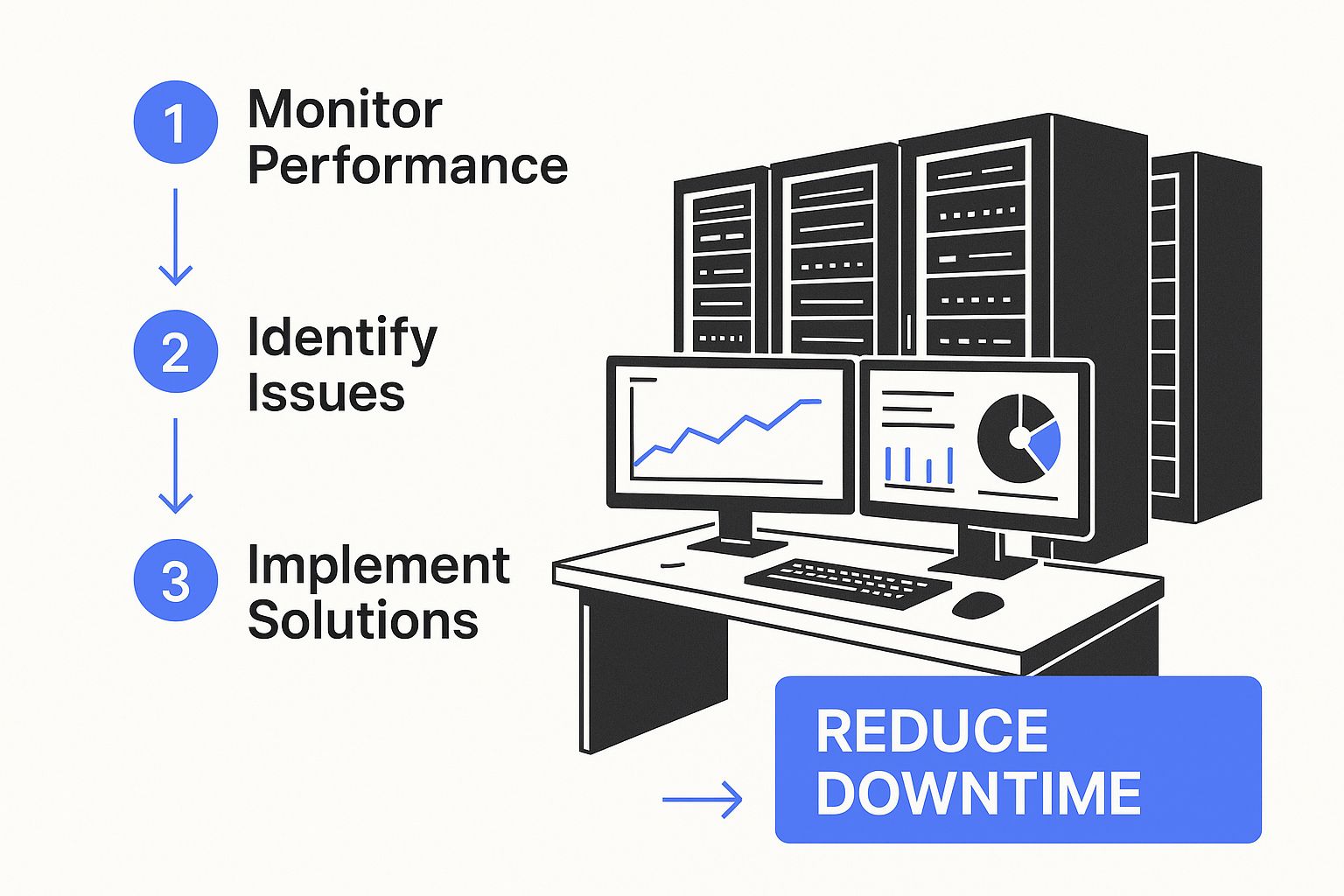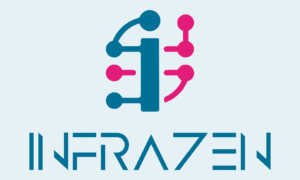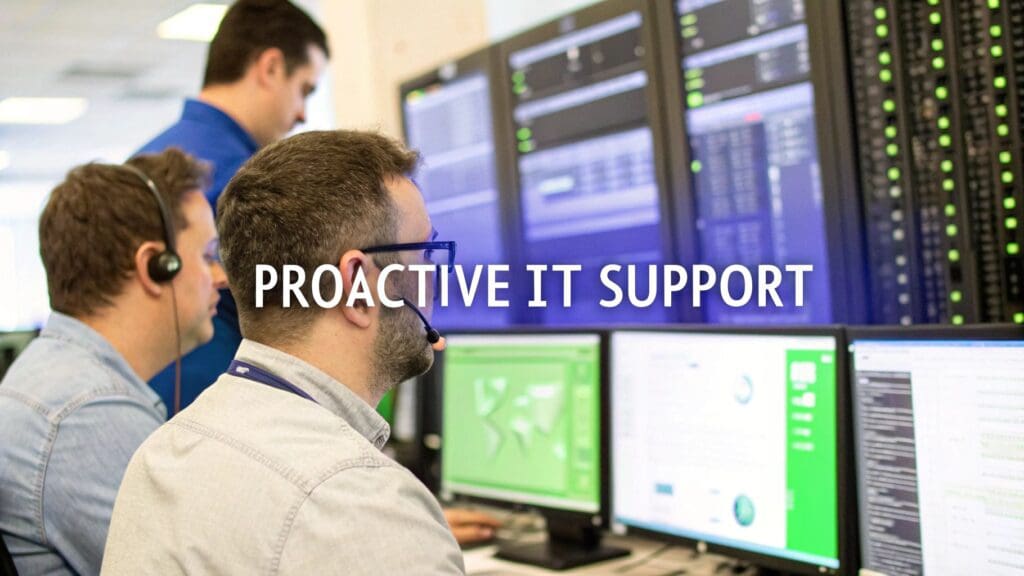Think of IT support like you would a car mechanic. For years, the standard approach was to only call for help after your car had broken down on the side of the motorway. This is the old way of thinking about IT.
Proactive IT support, on the other hand, is the modern equivalent of regular servicing, diagnostic checks, and preventative maintenance. It’s all designed to make sure that breakdown never happens in the first place.
The Critical Shift to Proactive IT Support
For a long time, the default for information technology was reactive. A server would crash, a network would fail, or a security breach would hit, and only then would the IT team scramble to pick up the pieces. This "break-fix" model is a high-stakes gamble, forcing businesses to work under the constant threat of disruption, data loss, and eye-watering emergency repair bills. That outdated strategy just doesn't cut it anymore.
The modern business world, especially for fast-paced sectors like creative and marketing agencies, depends on technology that simply works. Deadlines are non-negotiable, client data is incredibly sensitive, and any downtime translates directly into lost revenue and a damaged reputation. Waiting for disaster to strike isn't a strategy; it's an inevitability.
Moving from Firefighting to Prevention
Proactive IT support completely flips the script from firefighting to fire prevention. Instead of waiting for a problem to announce itself with a bang, this approach uses continuous monitoring, system health checks, and automated maintenance to quietly neutralise potential issues before they can ever impact your operations.
This shift is all about building a stable, secure, and efficient digital foundation where problems are anticipated and solved behind the scenes. It’s about creating an environment where your team can focus on what they do best—designing, creating, and innovating—without being constantly derailed by tech glitches.
The goal is to make IT so reliable it becomes invisible. When your technology works seamlessly, your team is more productive, your data is more secure, and your business is in a much better position to grow.
Why UK Businesses Are Making the Switch
This strategic change is mirrored in wider market trends. The UK's IT services market is seeing massive growth, valued somewhere between £105 billion and £112 billion in 2025 and projected to hit nearly £180 billion by 2032. A key driver behind this is the sharp rise in cloud adoption, which surged from 42% in 2020 to 53% in 2023 among UK organisations. As businesses embrace more complex systems, the cracks in the old break-fix model become glaringly obvious, making a proactive stance essential for managing a modern setup.
This isn't just a fleeting trend; it's a necessary evolution. For creative businesses, where digital assets are the absolute lifeblood of the company, protecting them is everything. The proactive model tackles this head-on by delivering:
- Continuous Security Monitoring: Actively hunting for threats instead of just cleaning up after a breach.
- Performance Optimisation: Making sure your software and hardware run at peak efficiency, preventing the kinds of slowdowns that kill creativity.
- Strategic Planning: Aligning your technology with your business goals, turning IT from a nagging cost centre into a genuine strategic asset.
This is especially true for marketing agencies, where reliable tech is non-negotiable. You can learn more about the specific benefits of tailored IT support for marketing agencies and how it can directly drive client success. The move to proactive IT support isn’t just about fixing things faster; it's about building a resilient business that's ready to thrive.
How Proactive IT Support Actually Works
So, what does proactive IT support actually look like in practice? To really get it, we need to lift the bonnet and see what’s going on underneath. It’s far from a vague promise; it’s a concrete system built on specific tech and methodical processes, all working in sync to keep your business running smoothly.
Think of it less like reacting to a loud, blaring alarm and more like listening for the quiet whispers that signal trouble is on the way.
The entire model is built on a foundation of 24/7 remote monitoring. Imagine these tools as the central nervous system for your whole IT setup. They are always active, constantly scanning your servers, network gear, and workstations for any sign of an anomaly. This could be anything from a server's temperature creeping up slightly to weird network traffic patterns or a hard drive showing the very first signs of failure.
This constant watchfulness gives us the raw data needed for the next, much smarter, layer of action.
The Power of Prediction and Automation
This is where the “proactive” part truly shines. Modern IT support doesn’t just gather data; it uses that data to forecast what’s coming next. By using AI and predictive analytics, providers can spot patterns that signal an impending problem long before it becomes a full-blown crisis. It’s a bit like getting a weather forecast warning you of a massive storm, giving you plenty of time to get ready instead of being caught in a downpour.
This predictive power is then paired with solid automation. Instead of a technician needing to manually apply security updates to every single computer one by one, automated systems handle it all seamlessly in the background. This makes sure that critical security patches are rolled out instantly across your entire organisation, closing vulnerabilities before anyone can even think about exploiting them.
This infographic shows how these pieces fit together to create a far more resilient IT environment.

As you can see, proactive support isn't a single action but a continuous loop of monitoring, analysing, and acting. It’s this cycle that dramatically reduces the chances of disruptive downtime hitting your business.
To make the difference crystal clear, let's compare the old way of doing things with the modern, proactive approach.
Reactive vs Proactive IT Support: A Head-to-Head Comparison
The table below breaks down how the two models stack up across the areas that matter most to a business.
| Feature | Reactive Support (Break-Fix) | Proactive IT Support (Managed) |
|---|---|---|
| Cost Model | Unpredictable, hourly billing. High costs for emergencies. | Predictable, flat monthly fee. Aligns with your budget. |
| Downtime | Frequent and disruptive. Support only starts after a failure. | Minimal to zero. Issues are prevented before they cause downtime. |
| Security | Vulnerable. Patches and updates are applied inconsistently. | Robust and layered. Constant monitoring and instant patching. |
| Productivity | Low. Staff are often blocked by recurring tech problems. | High. Systems are optimised to keep your team working without interruption. |
| Strategic Focus | None. The focus is purely on fixing what's broken. | High. Focus is on long-term stability, efficiency, and growth alignment. |
The contrast is stark. The reactive model keeps you stuck in a firefighting loop, whereas the proactive model offers a stable, strategic foundation for your business to build on.
A Continuous Cycle of Health and Optimisation
A proactive IT partnership isn't a one-time fix. It’s an ongoing commitment to the health of your digital world, involving a set of continuous activities that, while often invisible, are absolutely essential for resilience.
- Regular System Health Reports: You get clear, easy-to-understand reports that detail the status of your systems, the work that’s been done, and any potential risks on the horizon. This transparency means you’re always in the loop.
- Data-Driven Performance Tuning: By analysing performance data over time, your IT partner can make small tweaks to optimise speed and efficiency, ensuring your tech is always helping, not hindering, your team.
- Strategic Security Management: This goes way beyond simple antivirus software. It involves actively managing firewalls, monitoring for threats, and educating your team on best practices to create a multi-layered defence.
This methodical approach is fast becoming the new standard. The entire IT support industry in the UK is moving away from just fixing problems after they happen. Instead, the focus is shifting towards a strategic partnership model centred on optimisation and risk mitigation. This evolution is driven by business demand for uninterrupted system availability and operational continuity, using advanced monitoring and AI-powered analytics to resolve issues before they can affect performance. You can find more expert insights on this industry transformation and its impact.
This continuous process of improvement is what separates proactive IT support from its reactive predecessor. It transforms IT from a source of frustration into a stable foundation for growth.
Ultimately, all these elements combine to create a system where your technology is consistently cared for. It’s a quiet, diligent process that stops problems from ever happening in the first place, allowing your creative team to focus entirely on their work without interruption.
The Tangible Business Benefits of Going Proactive
Switching to proactive IT support is much more than a simple technical tweak. It’s a fundamental business decision, one that delivers tangible, bottom-line results that you’ll feel across the entire company—from your financial forecasts right down to daily team morale.
While the technical magic happens quietly in the background, the impact is impossible to ignore. This isn’t just about having fewer IT headaches; it’s about building a more resilient, efficient, and forward-thinking creative business. When you look at what a true proactive partnership delivers, the return on investment becomes crystal clear.
Dramatically Reduced Downtime
Every minute your systems are offline is a minute you can't work, bill clients, or hit deadlines. For a creative agency, downtime isn't just an annoyance; it’s a direct threat to your revenue and reputation. The costs are staggering, often running into thousands of pounds per hour for small and medium-sized businesses.
A proactive approach tackles this head-on. Instead of waiting for a server to fail or the network to grind to a halt, we’re already watching for the warning signs—like a hard drive showing early signs of stress or unusual network traffic. These issues are fixed long before they have a chance to escalate into a full-blown outage.
By preventing problems from happening in the first place, proactive IT support transforms downtime from a regular frustration into a rare exception. That stability gives your team the confidence to work without interruption, knowing the tools they depend on will always be ready when they need them.
Fortified Cybersecurity and Data Protection
For any creative agency, your digital assets and client data are your crown jewels. A data breach can be catastrophic, leading to financial penalties, a complete loss of client trust, and irreversible brand damage. Cybercriminals are relentlessly targeting UK businesses, and service industries like yours are prime targets because of the sensitive data you manage.
Relying on reactive security is like locking the door after the burglar has already left with your valuables. Proactive security, on the other hand, builds a fortress. It involves:
- Continuous Threat Monitoring: Actively hunting for and neutralising threats before they can breach your defences.
- Automated Security Patching: Instantly updating all your software to close security holes the moment a fix is available.
- Employee Security Training: Turning your team into a human firewall by teaching them to spot and avoid social engineering tricks like phishing emails.
This multi-layered defence makes your business a much tougher target, shielding your intellectual property and sensitive client information from harm.
Predictable IT Spending and Budgeting
One of the biggest headaches of the old break-fix model is its financial chaos. You might have a quiet month with zero IT costs, only to be hit with a disastrous one that brings a crippling emergency repair bill. This rollercoaster makes any kind of sensible financial planning almost impossible.
Proactive IT support works differently, typically on a fixed-fee monthly model. This gives you a predictable, consistent operational cost you can actually budget for. No more surprise invoices for emergency call-outs or unexpected hardware failures. This financial stability lets you allocate your resources with confidence, investing in growth instead of constantly stashing cash away for the next IT crisis. It turns your IT from a volatile financial risk into a manageable, predictable asset.
Boosted Employee Productivity and Morale
Few things crush a creative’s spirit more than being held back by slow, glitchy tech. When your team is constantly battling lagging software, network dropouts, or printing problems, their focus is torn away from the actual work they’re paid to do. This constant friction doesn’t just kill productivity; it creates widespread frustration and tanks morale.
Because proactive support keeps your systems optimised and running smoothly, these daily annoyances all but disappear. Your team can just get on with their jobs, free from the digital roadblocks that drain their time and energy. This seamless experience allows them to stay in a creative flow state, leading to better work, faster project turnarounds, and a genuinely happier team. When your tech just works, it empowers your people instead of holding them back.
What to Look For in a Modern Proactive IT Service

When you decide it’s time for proactive IT support, it’s crucial to know what you’re actually buying. Not all services are the same, and the gap between an average provider and a true partner can make or break your agency’s stability. A modern service is more than a helpdesk; it's a strategic asset built to protect and empower your creative work.
The starting point for any solid partnership is a clear and tailored Service Level Agreement (SLA). This isn't just a bit of paperwork. It’s a firm promise detailing guaranteed response times and fixes. For a creative agency on a deadline, knowing a critical issue will be looked at in minutes, not hours, is priceless.
But beyond the documents, the real value lies with the people. You need a support team that genuinely gets to know your business inside and out.
A Dedicated Team That Knows Your Business
A generic, faceless helpdesk can't deliver real proactive support because they lack context. They have no idea your lead designer is against a major client deadline or that the file server is most critical during the final week of a project.
A dedicated team, on the other hand, learns the rhythm of your business. They know the key players, the software you rely on, and the workflows that matter most. This familiarity allows them to find smarter, faster solutions and even anticipate problems before you voice them. They effectively become an extension of your own team, invested in your success.
True proactive support isn't about managing tickets; it's about understanding the people and processes behind the technology. This human-centric approach is what separates a basic service from a genuine strategic partnership.
Another non-negotiable? Financial clarity.
Transparent Pricing Without Hidden Fees
The old break-fix model is famous for its unpredictable costs, but a modern proactive service should offer financial stability. Look for providers with simple, all-inclusive pricing based on a flat monthly fee. You should never have to second-guess calling for help because you’re worried about the bill.
A transparent provider will clearly outline what’s included:
- Unlimited Support: Your team should feel free to reach out for any issue, big or small, without the meter running.
- All-Inclusive Maintenance: All the proactive work—monitoring, patching, and security updates—should be part of the core package.
- No Surprise Charges: The price you agree on should be the price you pay. It’s that simple. This allows for predictable budgeting.
This approach builds trust and ensures your IT provider is motivated to prevent problems, not profit from them.
Strategic Reviews and Technology Road-mapping
Excellent proactive support goes far beyond day-to-day fixes. Your provider should act as a strategic partner—a virtual Chief Information Officer (vCIO) who helps you look to the future. This involves regular strategic reviews to discuss what's working, what isn't, and what's next on the technology horizon.
These sessions are vital for aligning your IT with your long-term business goals. Your provider should help you build a technology roadmap, advising on future investments that will boost efficiency, improve security, or open up new creative possibilities. This is how IT stops being a cost centre and becomes an engine for growth.
To get this right, it helps to follow established best practices. You can explore some of our IT support best practices for UK creative agencies to learn more.
Implementing Proactive IT Support in Your Business

So, how do you actually make the switch? Moving from a reactive, break-fix model to a proactive framework isn’t like flipping a switch. It’s a deliberate process that involves building a new, more resilient foundation for your technology.
Think of it as a journey. It starts with a clear-eyed look at where you are now, so you can map out exactly where you need to go. The whole point is to make the transition smooth and structured, building a stronger, more secure IT environment around you without disrupting day-to-day operations.
For most businesses, that journey begins with a thorough look under the bonnet.
Starting with a Comprehensive IT Audit
Before you can build for the future, you have to get honest about the present. Any quality proactive IT partner will insist on starting with a comprehensive IT audit. This isn't a quick scan; it's a deep-dive assessment of your entire technology stack, designed to find hidden risks, workflow bottlenecks, and opportunities for real improvement.
It’s essentially a detailed health check for your agency’s digital infrastructure. The goal isn't to find fault, but to gather the hard facts. An audit will typically scrutinise a few key areas:
- Infrastructure Health: Looking at the age and performance of your servers, workstations, and network gear to spot any potential points of failure before they bring you down.
- Security Posture: Reviewing everything from your firewalls and antivirus to your data backup and recovery plans. This is all about finding and closing security gaps.
- Operational Workflows: Understanding how your team actually uses technology every day. Any new solutions have to support their creative process, not get in the way.
This audit gives you the crucial baseline data needed to build a real strategy. It replaces guesswork with facts.
A detailed IT audit is the first step in creating a true partnership. It ensures your new provider understands your unique setup from day one, allowing them to deliver solutions that are genuinely tailored to your agency's needs.
Defining Your Needs and Finding the Right Partner
Once the audit is done, the next step is turning those technical findings into clear business requirements. What are your absolute non-negotiables? Is it guaranteed uptime during a critical client pitch? Or is protecting sensitive client data the number one priority?
With these requirements clear, you can start looking for a provider that truly gets it. This is a massive decision. You aren't just hiring a supplier; you're choosing a partner who will be responsible for the digital backbone of your business. Look for someone who understands the creative industry and can show you they’ve supported businesses just like yours.
It's also a good time to be honest about whether your current IT is working. If you're constantly fighting the same fires or losing time to unexpected downtime, it’s probably time for a change. You can learn about the 10 warning signs your business needs managed IT services to help you take stock of your situation.
The Onboarding Journey and Building a Partnership
After you’ve chosen your partner, the onboarding process begins. This is where the proactive framework is carefully put into place. It’s a methodical process that includes deploying lightweight monitoring agents onto your systems. These agents act as the eyes and ears of your new support team, letting them watch over your systems' health 24/7.
A successful transition lives and dies by communication. Right from the start, your new partner should work with you to:
- Establish Clear Communication Channels: Define who to contact for what, and set up simple ways to get in touch, whether it's by phone, email, or a dedicated support portal.
- Set Performance Expectations: Agree on what success actually looks like. This includes key metrics for system performance, security standards, and support response times.
- Schedule Regular Strategic Reviews: Plan regular meetings to go over performance reports, discuss upcoming technology changes, and make sure your IT strategy keeps supporting your business goals.
This collaborative approach ensures a smooth handover and lays the foundation for a long-term, successful partnership. Ultimately, the goal of proactive IT support is to create a stable, secure, and seamless technology experience, freeing your team up to do what they do best—creating incredible work.
Still Have Questions? Let’s Clear Things Up
Making the switch to a new IT model always brings up a few questions. That’s perfectly normal. To help you get a clearer picture, we’ve tackled some of the most common queries we hear from business leaders when they’re thinking about moving to proactive IT support. Our goal is to cut through the jargon and give you straight, honest answers.
Isn't Proactive IT Support More Expensive Than Just Fixing Things When They Break?
It’s a fair question, but the answer is almost always no. While proactive support comes with a predictable monthly fee, it’s far more cost-effective in the long run. The old break-fix model seems cheaper on the surface, right up until a server crashes or a security breach hits you with a crippling emergency bill.
That’s what proactive IT support is designed to prevent. It stops those budget-destroying events before they even happen. By eliminating expensive downtime, preventing catastrophic data loss, and getting rid of surprise repair fees, it saves you a significant amount of money and stress. This predictable cost also makes budgeting a whole lot easier than trying to manage the financial chaos of a reactive approach.
Will We Lose Control Over Our IT if We Outsource It?
Not at all. A good proactive provider works as your strategic partner, not as a replacement for your own decision-making. You’re not handing over the keys; you’re gaining a dedicated team of experts whose sole focus is keeping your business stable and secure. You always remain in the driver’s seat.
A true proactive partnership is about collaboration. You set the business strategy and define the goals; the provider makes sure the technology is perfectly aligned to help you achieve them. They handle the complex, day-to-day grind so your team can focus on what they do best: growing the business.
How Quickly Will We See Results After Making the Switch?
You'll notice some benefits almost straight away. From day one, you should see a drop in those small, frustrating IT hiccups that slow your team down. When you do need help, you’ll also find that the response is much faster and more effective because the support team already knows your systems inside and out.
The bigger, more profound advantages really start to show over the first few months. This is when your provider has had the time to fully stabilise your environment and implement key preventative measures. At this point, you'll see a dramatic fall in major incidents, far less downtime, and a much stronger security posture. That’s when you get to experience genuine peace of mind.
Ready to build a more resilient and efficient creative business? InfraZen offers specialised proactive IT support that lets your team focus on what they do best. Discover how we can help you work securely and without interruptions.

